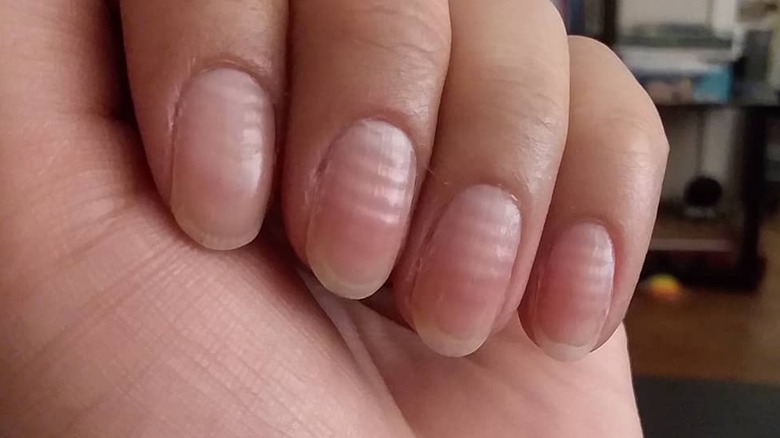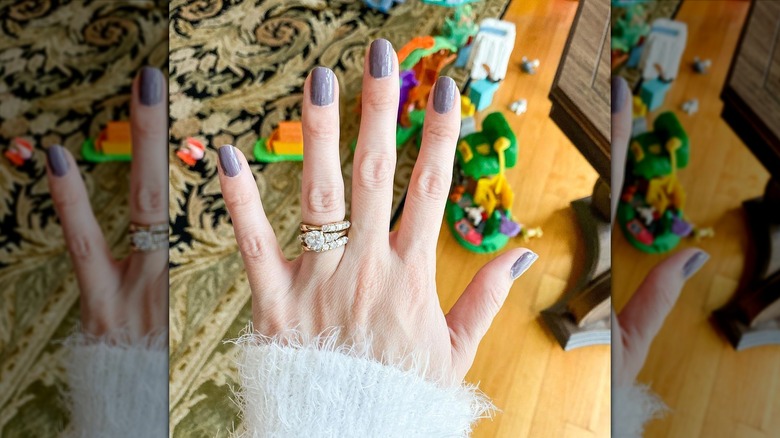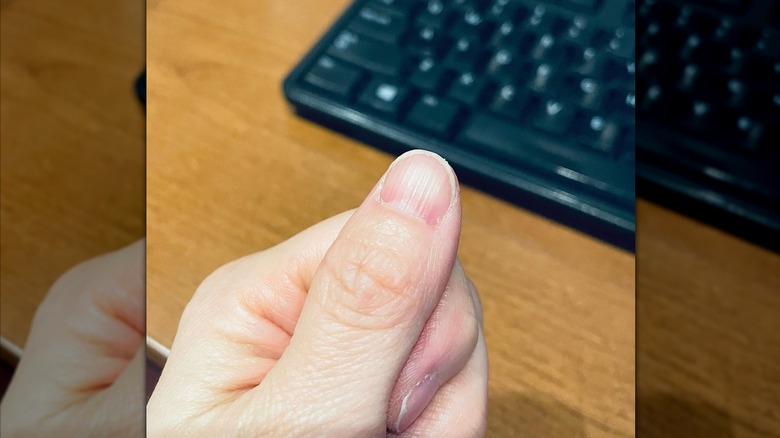What It Really Means When Ridges Appear On Your Nails
Ever noticed those pesky ridges on your nails and wondered why they're there? Yes? Then you've come to the right place. As board-certified dermatologist Dr. Lawrence E. Gibson explained to Mayo Clinic, ridges on the nails may mean more than you think. And it's the direction they're going that's really important.
If your nail ridges are running vertically from the tip of the nail to the nail bed (known medically as longitudinal ridges), then this can happen naturally over time due to the nail's natural cells. They could also be caused by skin conditions, such as eczema, or could occur in people who have thyroid disease — but that doesn't mean it's anything serious. "Longitudinal ridging of nails is usually age-related and usually nothing to worry about," Dr. Angela Kim, a board-certified dermatologist, told Good Housekeeping.
However, if you've noticed horizontal ridges going from one side of the nail to the other, it's a good idea to get checked out by a doctor. While there's no reason to panic, these ridges could potentially be a sign of a medical issue, such as Beau's Lines. It could mean that your nails have become more seriously damaged, be a sign of peripheral vascular disease (PAD), or an illness such as COVID-19 or pneumonia. Those going through chemotherapy may also notice horizontal ridges, as could people with diabetes or a vitamin deficiency. But, don't worry, because there are still plenty of treatments and preventative methods out there.
Ways to treat nail ridges
No matter which way the ridges on your nails run, there are ways to treat nail ridges. Of course, if you're experiencing horizontal lines (or very noticeable vertical lines for that matter), the best way to deal with the issue is to speak to a medical professional. They'll be able to determine what's behind the ridges and provide a personalized treatment method. If your lines are vertical and you're certain they're not due to a medical issue, or you know exactly what's causing your horizontal ridges and you have approval from your doctor, then there are a few ways to treat the problem yourself.
You may be tempted to buff the ridges out, but Dr. Saya Obayan, a board-certified dermatologist told Good Housekeeping that may be a bad idea. "It causes destruction to the nail plate, and it can make it thinner and much more likely to break," she shared, noting if you do have to buff your nails, don't do it more than twice a month. Dr. Obayan also recommended using a nail hardener after.
Other ways to treat nail ridges? Try to keep your hands out of water. Board-certified dermatologist Dr. Noelani González explained to Prevention that, just like over-washing your hair, washing your hands too often can strip it of the natural oils needed to prevent ridges. You could also try a ridge filler product, which will help reduce the appearance of ridges and make nail polish go on smoother.
There are ways to prevent nail ridges, too
As they say, prevention is better than cure. And there are ways to stop nail ridges in their tracks before they become too much of an issue. One of the best ways to take care of your nails is through regular manicures. Ones that don't include cutting the cuticles, though (despite what you may have read). "It is important to not remove your cuticles during manicures and to keep the area moisturized. Protecting the cuticles will protect your nail matrix stem cells so that your nails stay healthy and grow normally," Dr. Angela Kim explained to Good Housekeeping. And that may also include (shocker, we know!) bare nails days for a break from polishes. Because of that, when we say manicure, we don't mean constant harsh gel manicures. "If an electric file or aggressive scraping is [used], the nail matrix can be damaged and the nail plate can develop surface irregularities or also become too thin," dermatologist Dr. Dana Stern told Allure. And that process could worsen ridges.
Regular moisturizing of the hands and nails can also be a great ridge preventer, because it can help to protect the keratin and minimize the appearance of ridges, shared board-certified dermatologist Dr. Donna Hart to Prevention. Another tip? A change in your daily routine may also help. Dr. Dana Stern told Byrdie, "Regular cardiovascular activity will help with peripheral perfusion to the digits (blood flow) and help with ridging."


